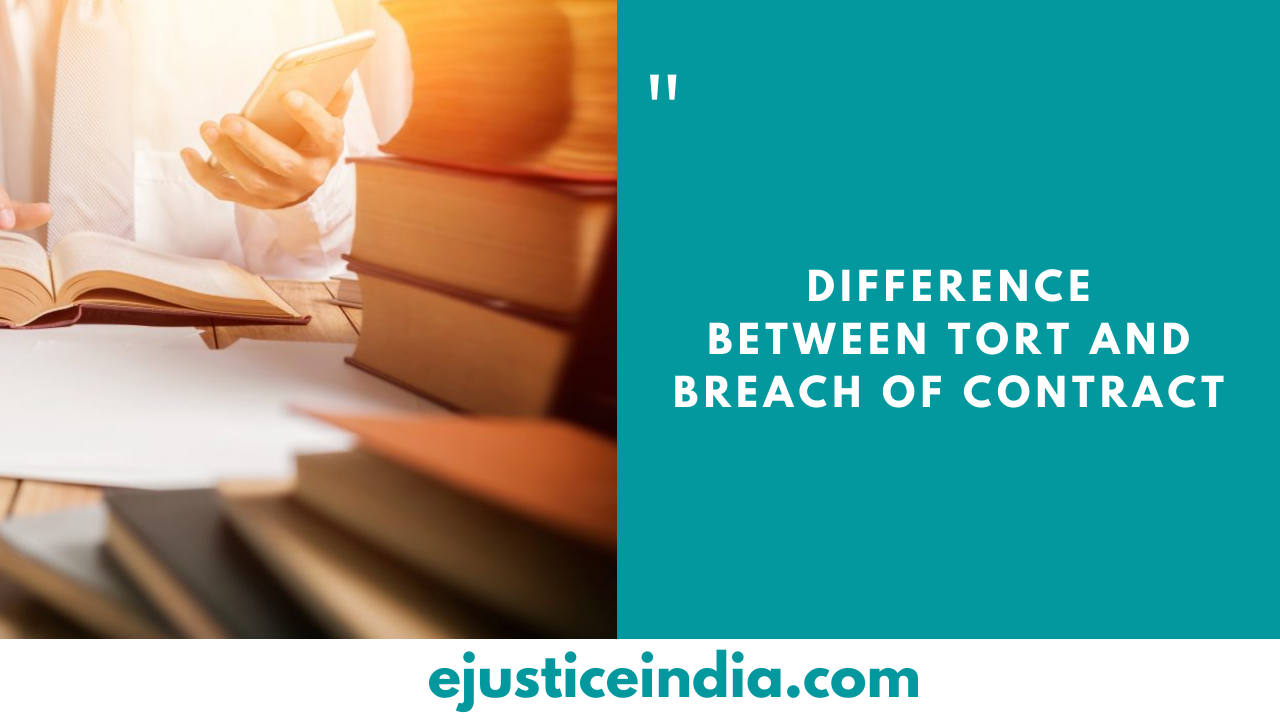Difference between Law of Tort and Law of Torts
Difference between Law of Tort and Law of Torts
Author : Gouri Kailash
INTRODUCTION
The word tort has been derived from the Latin word “Tortum” which means an injury or wrong. It also means to twist. Tort is a wrong done to a person and the injured person can recover damages from him which is mainly monetary compensation. The injured party can recover damages from the defendant for the wrong done to him. In certain cases the defendant would not have had the intention to commit the wrong but by negligence he must have caused injury to the other person, in such cases also the defendant will be liable for the damage caused.
The defendant is the person who commits the tort. It can either be one person, or a number of persons, joint tortfeasors and the wrongful act done by them is called tortious act and they can be sued either jointly or individually.
Sir John Salmond defined tort as “as a civil wrong for which the remedy is common law action for unliquidated damages and which is not exclusively the breach of contract or breach of trust or other merely equitable obligation.” (Salmond)
Essentials of Tort
- Act/ omission: In tort there should have been a wrongful act or an omission to do an act and it should have caused an injury or violated the legal rights of another person. In such cases it would amount to a tortious act.
- Legal Damage: The wrongful act or injury should have given rise to a legal or an actual damage.
Types of Torts
Torts can be mainly classified into three:
- Intentional Tort
- Negligence
- Strict Liability
- Intentional tort can be further classified as:
- Assault: An assault can be termed as an attempted battery where the wrongdoer does not actually hit but creates an impression in your mind that he is about to strike you.
Illustration: A points a gun towards B and creates a fear on B that he is about to shoot. It is assault.
- Battery: Battery means to hit or strike someone or touch them in an offensive manner.
- False imprisonment: It means to falsely imprison a person and restrict his or her movement against their will.
- Fraud: It basically means to lie to someone.
- Defamation: It means when someone falsely maligns the reputation of another and causes him harm. Defamation can either be libel (written) or slander (spoken).
- Trespass: Trespass means to use the property of another without their permission. It can be trespass to land or chattel.
- Intentional infliction of emotion distress: It means that a person has indulged in an extremely outrageous conduct and has frightened the other person which makes him emotionally distressed.
- Invasion of privacy etc.
- Negligence
Here the tort is caused by accident or mistake of the defendant and causes any injury or damage without wrongful intention.
- Strict Liability
In strict liability the defendant will be held responsible for his actions without the plaintiff having to prove the negligence or fault on part of defendant. For instance using explosives or wild animals, they will be held liable if a person is injured.
Under strict liability the defendant cannot take the defense that he had taken necessary precautions. He should be able to foresee the harm that maybe caused.
Development of tort in India
The term has been used in India even before the pre independence period. The law of torts in India is based on the English law itself however before applying the English rule the judges will see whether it can be applied in the Indian society. The law of torts is underdeveloped in India because people are mostly unaware about the law. Because there is no code for the law of torts not many people will go the courts as they will be unsure of the outcome.
Law of tort vs. Law of torts

Is it law of tort or law of torts is a question that has been under study by various jurists. Different jurists have theories regarding this. There are mainly two competing theories regarding this: one says that all the wrongful acts are torts unless there is a legal justification while the other one says that there are only definite number of torts such as trespass, defamation etc. and the plaintiff has to bring a suit under any of these definite torts.
Law of Tort:
This theory has been propounded by Winfield. He is the main supporter of this theory. According to him all the wrongful acts done against a person shall come under tort unless it has a legal justification. Therefore all the wrongs done shall be a tortious act irrespective of whether it comes under a specified tort. It does not need to fall under a specific name. This theory is a wider concept as it tries to include all kinds of wrongs.
There are various other supporters of this theory such as:
Holt C.J favored Winfield’s theory by recognizing the principle ubi jus ibi remedium which means where there is a right there is a remedy.
According to Lord Macmillan “the common law is not proved powerless to attach new liabilities and create new duties where experience has proved that it is desirable with reference to the case Donoughe vs. Stevenson (1932) AC 595 (Macmillon, 1932)
There are certain new torts which have been created under this:
- The tort of inducement to a wife to leave husband was development in the case Winsmore vs. Greenbank1
- The tort of deceit in the case Pasley vs Freeman2
- The tort of inducement of breach of contract was developed in Lumley vs. Gye3
- The landmark decision of strict liability in Rylamds vs. Fletcher4
- (Winsmore vs Greenbank, 1745)
- (Pasley vs Freeman , 1789)
- (Lumley vs Gye, 1853)
- (Rylands vs Fletcher , [1868] UKHL 1)
The Indian judiciary also supports the Winfield theory
According to Justice Bhagwati “we have to evolve new principles and lay down new norms which will adequately deal with new problems which arise in highly industrialized economy. We cannot allow our judicial thinking to be constricted by reference to the law as it prevails in England….. We are certainly prepared to receive light from whatever source it comes but we have to build our own jurisprudence.” (M.C Mehta vs. Union of India, 1987 (SCR) 1 819, AIR 1987 965)
This case originated after the oleum gas leak from Shriram Food and Fertilisers ltd which killed one person and injured a few persons. In this case the principle of absolute liability was introduced.
This was an example that new torts could be introduced and that the Indian judicial system supported the Winfield theory
Law of Torts
Salmond was in support of this theory. According to him there was no law of tort but only law of torts. This theory is also called the pigeon hole theory. Under this theory there is no general principle of liability but the plaintiff has to place the wrongful act in any one of the pigeon holes i.e. a specified tort such as defamation, trespass etc. only then can he claim any damages. If the plaintiff cannot place the wrongful act in any particular pigeon hole then it means the defendant has not committed any tortious act.
This theory is a more narrow theory because in most cases the plaintiff maybe unable to classify the wrong done against him into a specified tort. He may not be able to place the wrong in any of the pigeon holes and this would make it easier for the defendant to escape from liability.
According to Salmond the law of torts should also contain a set of rules in in order to specify the wrongs.
There are certain jurists who support Salmond’s theory they are:
Professor Dr. Jenks he was a supporter of Salmond though according to him new torts could be created provided that they were similar to the already existing ones.
Heuston was also of the same view as Salmond’s theory of law of torts.
In Bolllinger vs. Costa Brava Wine Co. Ltd it was held that for a person to claim damages it must be proved that wrongful act falls under one of the specified torts. (Bollinger vs. Costa Brava Wine Co ltd, [1961] 1 W.L.R 277)

CONCLUSION
There are two theories to determine whether it is law of tort or law of torts one is the Winfield’s theory and the other is Salmond’s theory also known as the pigeon hole theories. From these two theories we can understand that the former is a broader concept while the latter is a narrow concept. According to Winfield both the theories are correct however it depends on the way we look at these theories. While one is a broader concept and new torts can be created the other is a narrow concept with specified labeled torts and only those wrongful acts which come under the labeled tort can be used by the plaintiff to claim damages. It depends on the person to see which one is better. However Winfield’s theory is used because of its broader concept. Even the Indian judicial system prefers the Winfield’s theory as they can create new torts which can be seen in the case of absolute liability.


